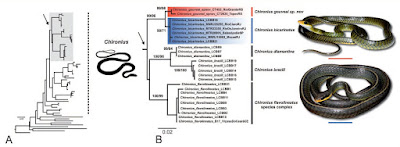 |
| Chironius gouveai
Entiauspe-Neto, Lyra, Koch, Quintela, Abegg & Loebmann, 2020
|
Abstract
Chironius bicarinatus is a conspicuous colubrid snake species, widely distributed in northeastern, southeastern, central-western, and southern Brazil, as well as Paraguay, Argentina, and Uruguay. On the basis of new morphological data of individuals from previously unsampled regions and deoxyribonucleic acid sequences, we reviewed the taxonomy of populations previously referred to as C. bicarinatus, revisiting the species definition with an updated diagnosis, inferring its phylogenetic relationships with closely related lineages in southern Brazil, herein described as a new species restricted to Pampa forests or grasslands and Atlantic Forest semidecidual forests in southern Brazil. The new species can be readily diagnosed from C. bicarinatus and all other congeners on the basis of internal (hemipenis unilobed, unicalyculate, cylindrical, apex with smooth calyces, with spinules restricted to proximal portion, near the medial area; lacrimal foramen with small projection on the anteroventral margin) and external morphology (ventrals 153–165 [153–165 in males, 155–164 in females]; subcaudals 103–146 pairs [129–142 in males, 103–146 in females]; adult dorsal pattern with dark green background, scales sometimes with light blue margin, two conspicuous black dorsal stripes with light green vertebral stripe between them that gradually dissipates to the tail, ventrals with black margin on its edges) and molecular evidence.
Chironius gouveai
Omar Machado Entiauspe-Neto, Mariana Lúcio Lyra, Claudia Koch, Fernando Marques Quintela, Arthur Diesel Abegg and Daniel Loebmann. 2020. Taxonomic Revision of Chironius bicarinatus (Wied 1820) (Serpentes: Colubridae), with Description of A New Species. Herpetological Monographs. 34(1); 98-115. DOI: 10.1655/HERPMONOGRAPHS-D-19-00013.1 twitter.com/EntiauspeM/status/1288576221740183553









